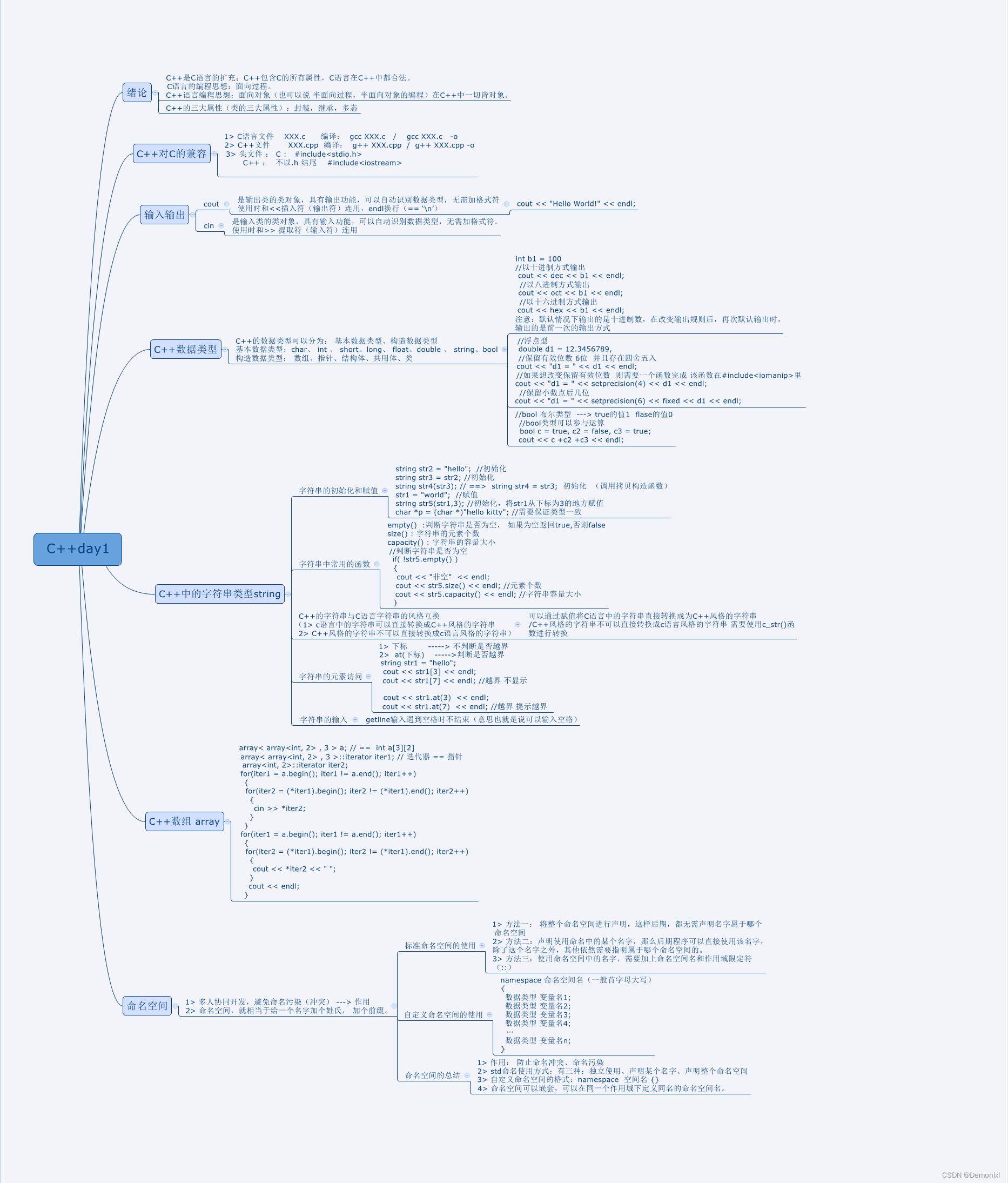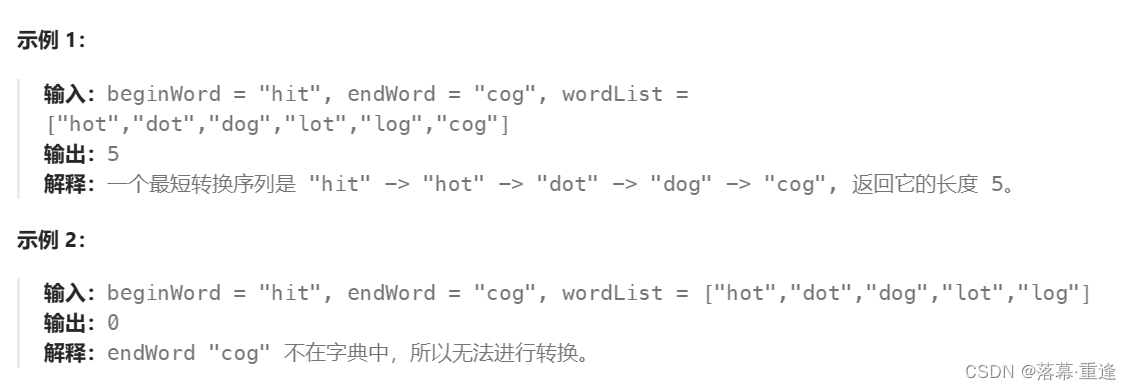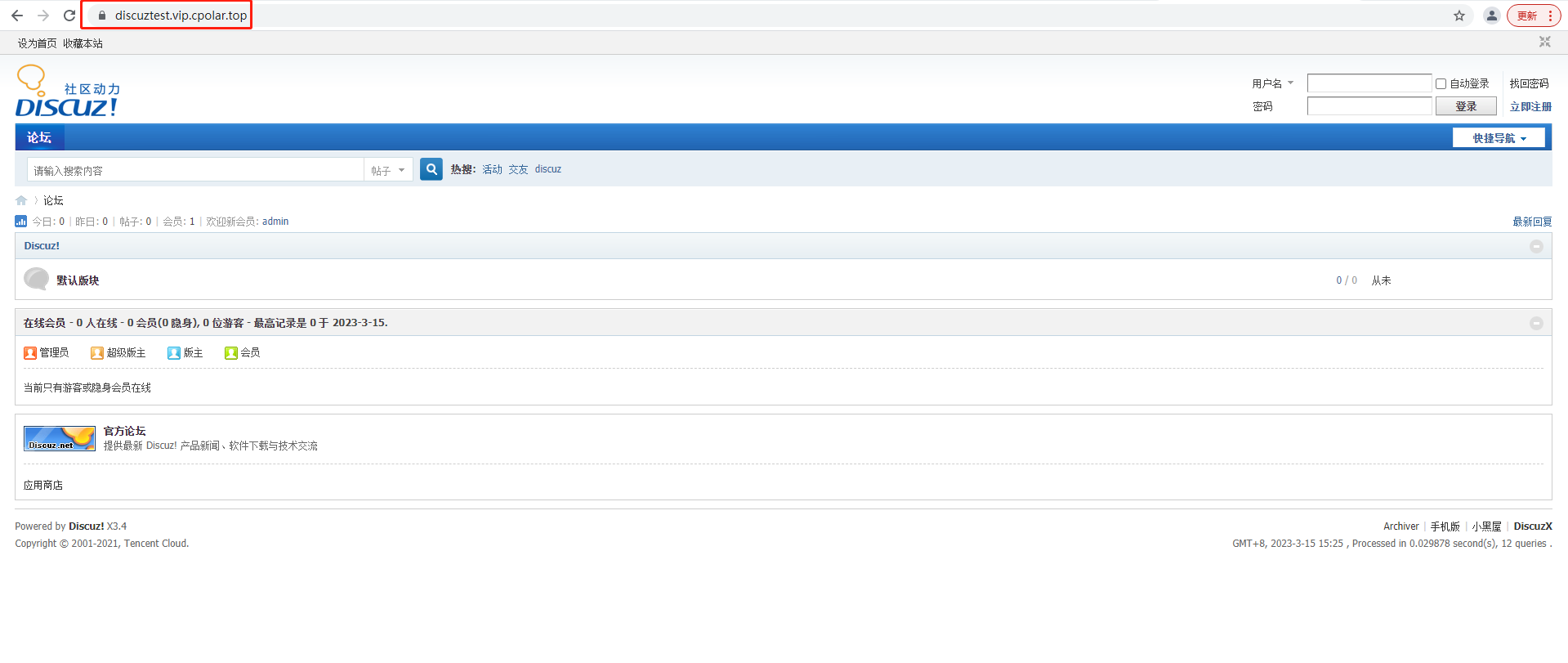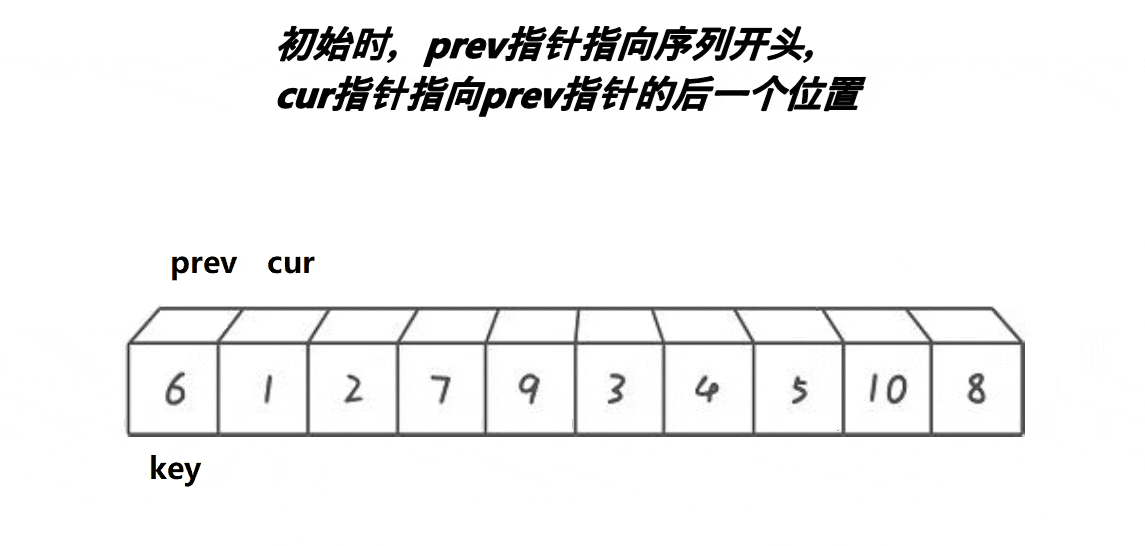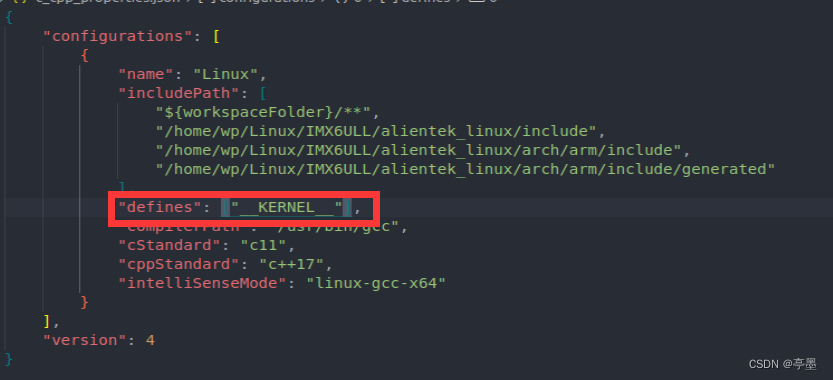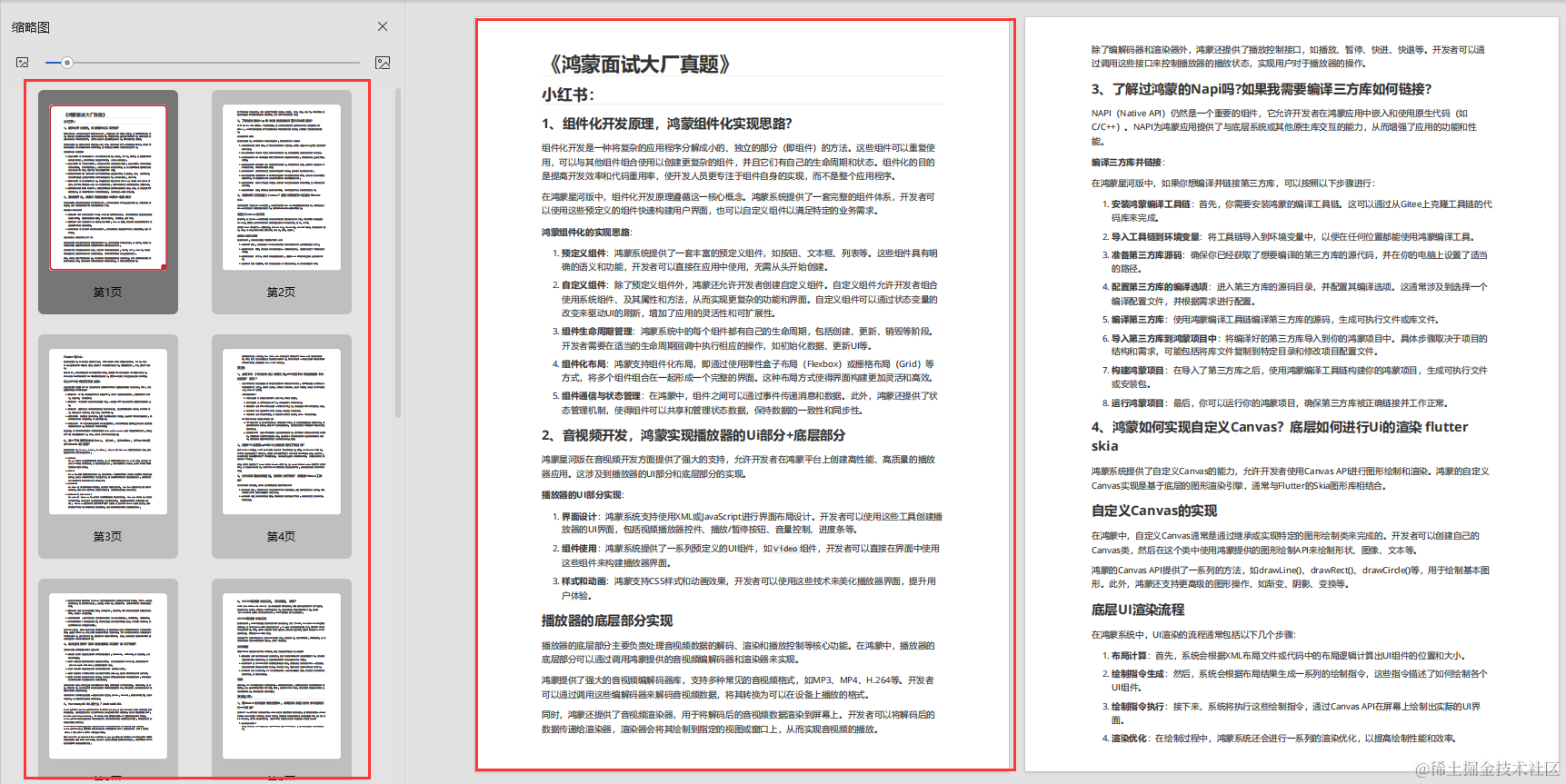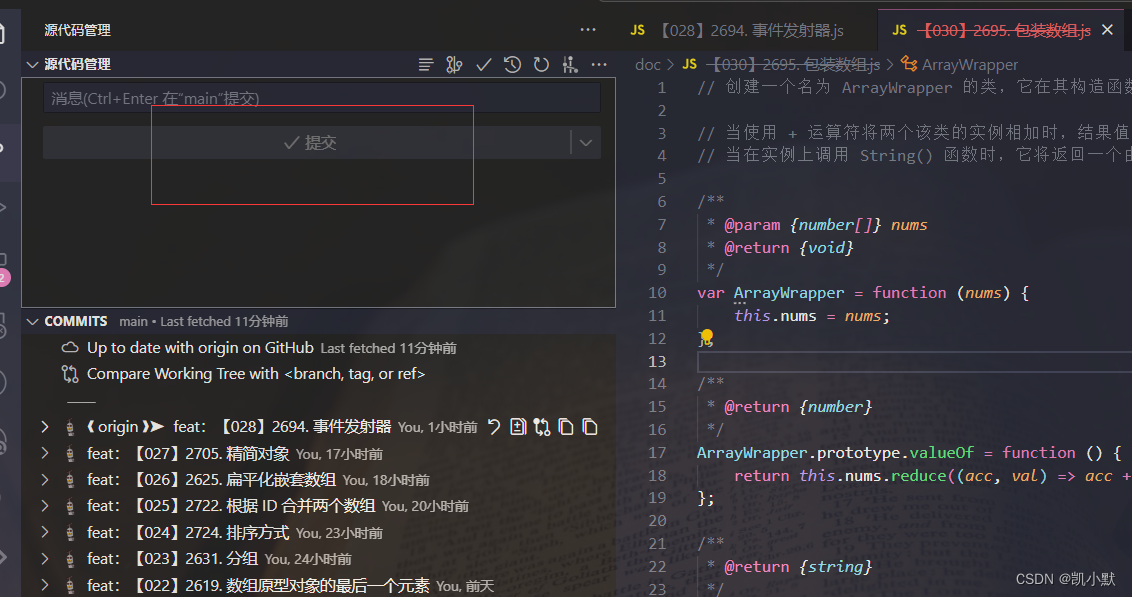继承
为什么需要继承
Java中使用类对现实世界中实体来进行描述,类经过实例化之后的产物对象,则可以用来表示现实中的实体,但是现实世界错综复杂,事物之间可能会存在一些关联,那在设计程序是就需要考虑。
比如:狗和猫,它们都是一个动物。

使用Java语言来进行描述,就会设计出:
class Dog{public String name;public int age;public String color;public void eat(){System.out.println(this.name+"正在吃饭!");}public void bark(){System.out.println(this.name+"正在汪汪汪!");}
}class Cat{public String name;public int age;public String color;public void eat(){System.out.println(this.name+"正在吃饭!");}public void bark(){System.out.println(this.name+"正在喵喵喵!");}}
public class Test2 {public static void main(String[] args) {Dog dog=new Dog();dog.name="阿黄";dog.age=1;dog.color="黄色";dog.eat();dog.bark();Cat cat=new Cat();cat.name="小花";cat.age=2;cat.color="白色";cat.eat();cat.bark();}
}通过观察上述代码会发现,猫和狗的类中存在大量重复,如下所示: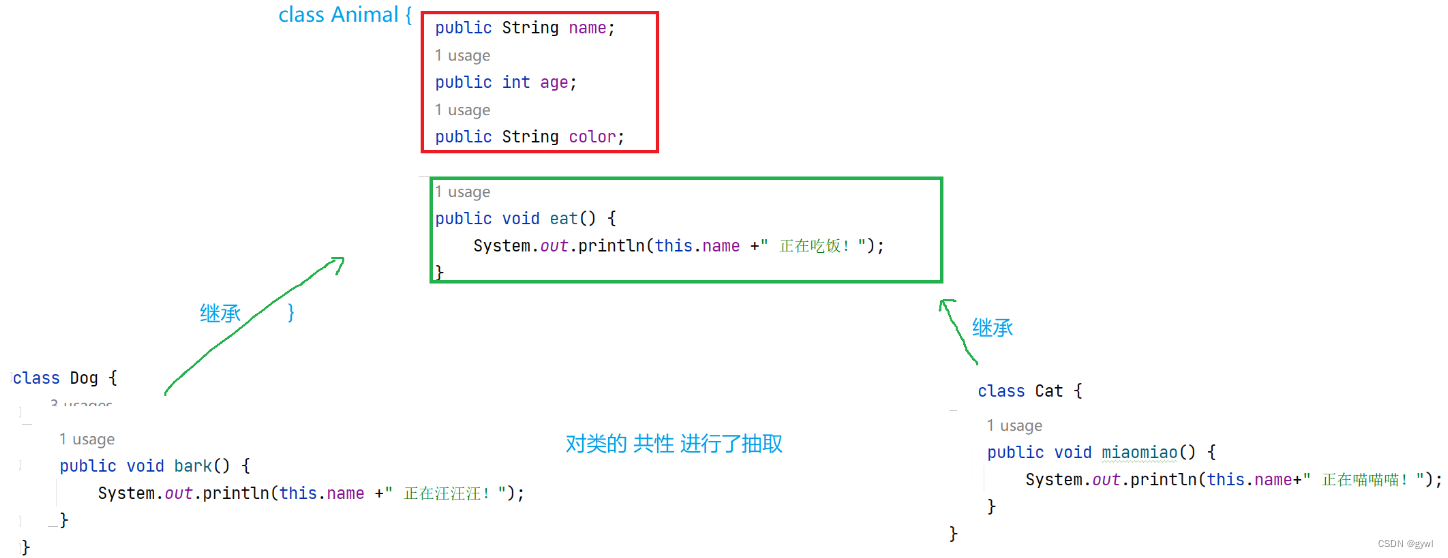
那能否将这些共性抽取呢?面向对象思想中提出了继承的概念,专门用来进行共性抽取,实现代码复用。
继承概念
继承(inheritance)机制:是面向对象程序设计使代码可以复用的最重要的手段,它允许程序员在保持原有类特 性的基础上进行扩展,增加新功能,这样产生新的类,称派生类。继承呈现了面向对象程序设计的层次结构, 体现了由简单到复杂的认知过程。继承主要解决的问题是:共性的抽取,实现代码复用。
例如:狗和猫都是动物,那么我们就可以将共性的内容进行抽取,然后采用继承的思想来达到共用。
上述图示中,Dog和Cat都继承了Animal类,其中:Animal类称为父类/基类或超类,Dog和Cat可以称为Animal的子类/派生类,继承之后,子类可以复用父类中成员,子类在实现时只需关心自己新增加的成员即可。
从继承概念中可以看出继承最大的作用就是:实现代码复用,还有就是来实现多态(后序讲)。
继承的语法
在Java中如果要表示类之间的继承关系,需要借助extends关键字,具体如下:
修饰符 class 子类 extends 父类 {
// ...
}
package demo1;class Animal{public String name;public int age;public String color;public void eat(){System.out.println(this.name+"正在吃饭!");}}
class Dog extends Animal{public void bark(){System.out.println(this.name+"正在汪汪汪!");}
}class Cat extends Animal{public void bark(){System.out.println(this.name+"正在喵喵喵!");}}
public class Test2 {public static void main(String[] args) {Dog dog=new Dog();dog.name="阿黄";dog.age=1;dog.color="黄色";dog.eat();dog.bark();Cat cat=new Cat();cat.name="小花";cat.age=2;cat.color="白色";cat.eat();cat.bark();}
}
注意:
1. 子类会将父类中的成员变量或者成员方法继承到子类中了
2. 子类继承父类之后,必须要新添加自己特有的成员,体现出与基类的不同,否则就没有必要继承了
父类成员访问
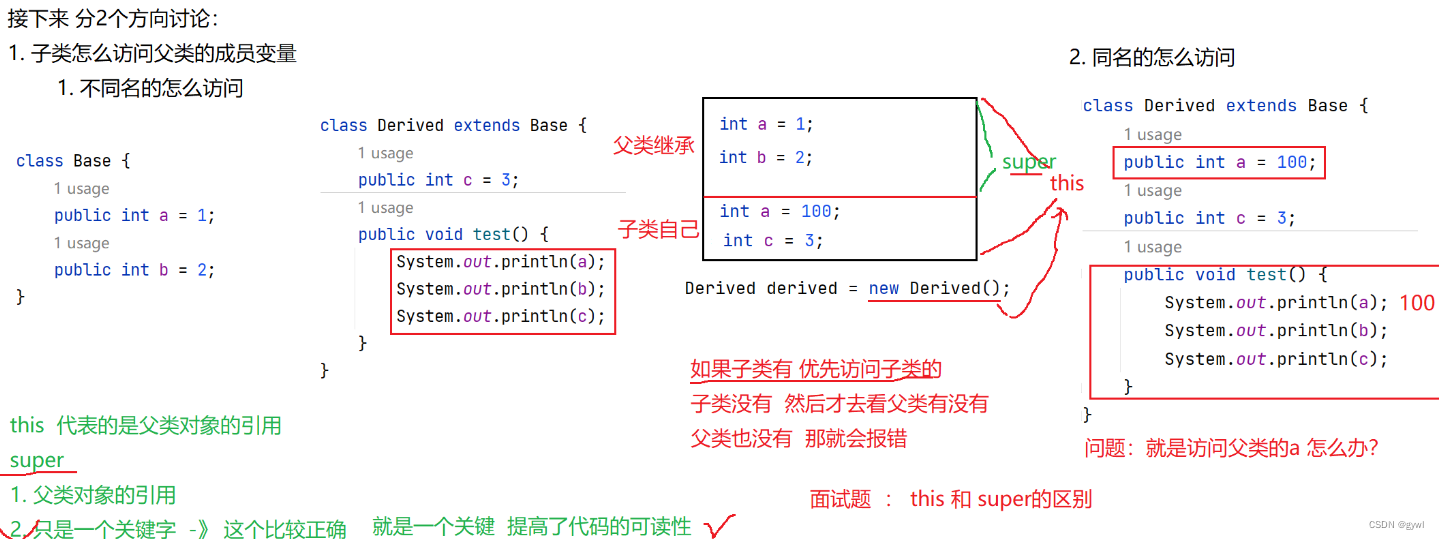
子类中访问父类的成员变量
1. 子类和父类不存在同名成员变量
package demo1;/*如果子类有,优先访问子类的,
子类没有,然后才去看父类有没有
父类也没有,那就会报错
* */
class Base{public int a=1;public int b=2;
}
class Derived extends Base{public int c=3;public void test(){System.out.println(a);System.out.println(b);System.out.println(c);}
}
在子类方法中 或者 通过子类对象访问成员时:
如果访问的成员变量子类中有,优先访问自己的成员变量。
如果访问的成员变量子类中无,则访问父类继承下来的,如果父类也没有定义,则编译报错。
如果访问的成员变量与父类中成员变量同名,则优先访问自己的。
成员变量访问遵循就近原则,自己有优先自己的,如果没有则向父类中找。
2. 子类和父类成员变量同名
class Base{public int a=1;public int b=2;
}
class Derived extends Base{public int a=100;public int c=3;public void test(){System.out.println(a);System.out.println(b);System.out.println(c);}
}
public class Test3{public static void main(String[] args) {Derived derived=new Derived();derived.test();}
}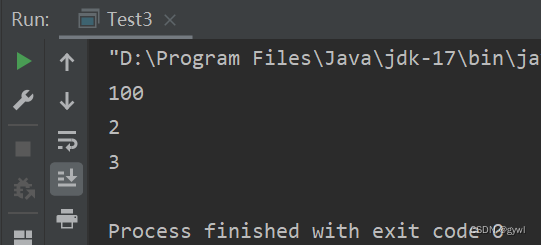
子类中访问父类的成员方法
1. 成员方法名字不同
package demo1;class Base2{public void testA(){System.out.println("testA()");}}class Derived2 extends Base2{public void testA(){System.out.println("Derived2::testA()");}public void testB(){System.out.println("testB()");}public void testC(){this.testA();this.testB();}
}public class Test4 {public static void main(String[] args) {Derived2 derived2=new Derived2();derived2.testC();}
}
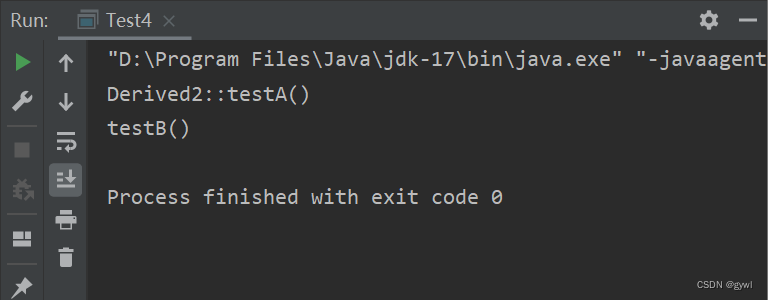
总结:成员方法没有同名时,在子类方法中或者通过子类对象访问方法时,则优先访问自己的,自己没有时到父类中找,如果父类中也没有则报错。
2. 成员方法名字相同
public class Base {
public void methodA(){
System.out.println("Base中的methodA()");
}
public void methodB(){
System.out.println("Base中的methodB()");
}
}
public class Derived extends Base{
public void methodA(int a) {
System.out.println("Derived中的method(int)方法");
}
public void methodB(){
System.out.println("Derived中的methodB()方法");
}
public void methodC(){
methodA(); // 没有传参,访问父类中的methodA()
methodA(20); // 传递int参数,访问子类中的methodA(int)
methodB(); // 直接访问,则永远访问到的都是子类中的methodB(),基类的无法访问到
}
}【说明】
通过子类对象访问父类与子类中不同名方法时,优先在子类中找,找到则访问,否则在父类中找,找到则访问,否则编译报错。
通过派生类对象访问父类与子类同名方法时,如果父类和子类同名方法的参数列表不同(重载),根据调用方法适传递的参数选择合适的方法访问,如果没有则报错;
问题:如果子类中存在与父类中相同的成员时,那如何在子类中访问父类相同名称的成员呢?
super关键字
由于设计不好,或者因场景需要,子类和父类中可能会存在相同名称的成员,如果要在子类方法中访问父类同名成员时,该如何操作?直接访问是无法做到的,Java提供了super关键字,该关键字主要作用:在子类方法中访问父类的成员。
package demo1;class Base2{public void testA(){System.out.println("testA()");}}class Derived2 extends Base2{public void testA(){System.out.println("Derived2::testA()");}public void testB(){System.out.println("testB()");}public void testC(){this.testA();super.testA();this.testB();}
}public class Test4 {public static void main(String[] args) {Derived2 derived2=new Derived2();derived2.testC();}
}

在子类方法中,如果想要明确访问父类中成员时,借助super关键字即可。
【注意事项】
1. 只能在非静态方法中使用

2. 在子类方法中,访问父类的成员变量和方法。
super的其他用法在后文中介绍。
子类构造方法
父子父子,先有父再有子,即:子类对象构造时,需要先调用基类构造方法,然后执行子类的构造方法。
public class Base {
public Base(){
System.out.println("Base()");
}}
public class Derived extends Base{
public Derived(){
// super(); // 注意子类构造方法中默认会调用基类的无参构造方法:super(),
// 用户没有写时,编译器会自动添加,而且super()必须是子类构造方法中第一条语句,
// 并且只能出现一次
System.out.println("Derived()");
}}
public class Test {
public static void main(String[] args) {
Derived d = new Derived();
}
}
//结果打印:
//Base()
//Derived()在子类构造方法中,并没有写任何关于基类构造的代码,但是在构造子类对象时,先执行基类的构造方法,然后执行子类的构造方法,因为:子类对象中成员是有两部分组成的,基类继承下来的以及子类新增加的部分 。父子父子肯定是先有父再有子,所以在构造子类对象时候 ,先要调用基类的构造方法,将从基类继承下来的成员构造完整,然后再调用子类自己的构造方法,将子类自己新增加的成员初始化完整。
注意:
1. 若父类显式定义无参或者默认的构造方法,在子类构造方法第一行默认有隐含的super()调用,即调用基类构造方法。
2. 如果父类构造方法是带有参数的,此时需要用户为子类显式定义构造方法,并在子类构造方法中选择合适的父类构造方法调用,否则编译失败。
3. 在子类构造方法中,super(...)调用父类构造时,必须是子类构造函数中第一条语句。
4. super(...)只能在子类构造方法中出现一次,并且不能和this同时出现。
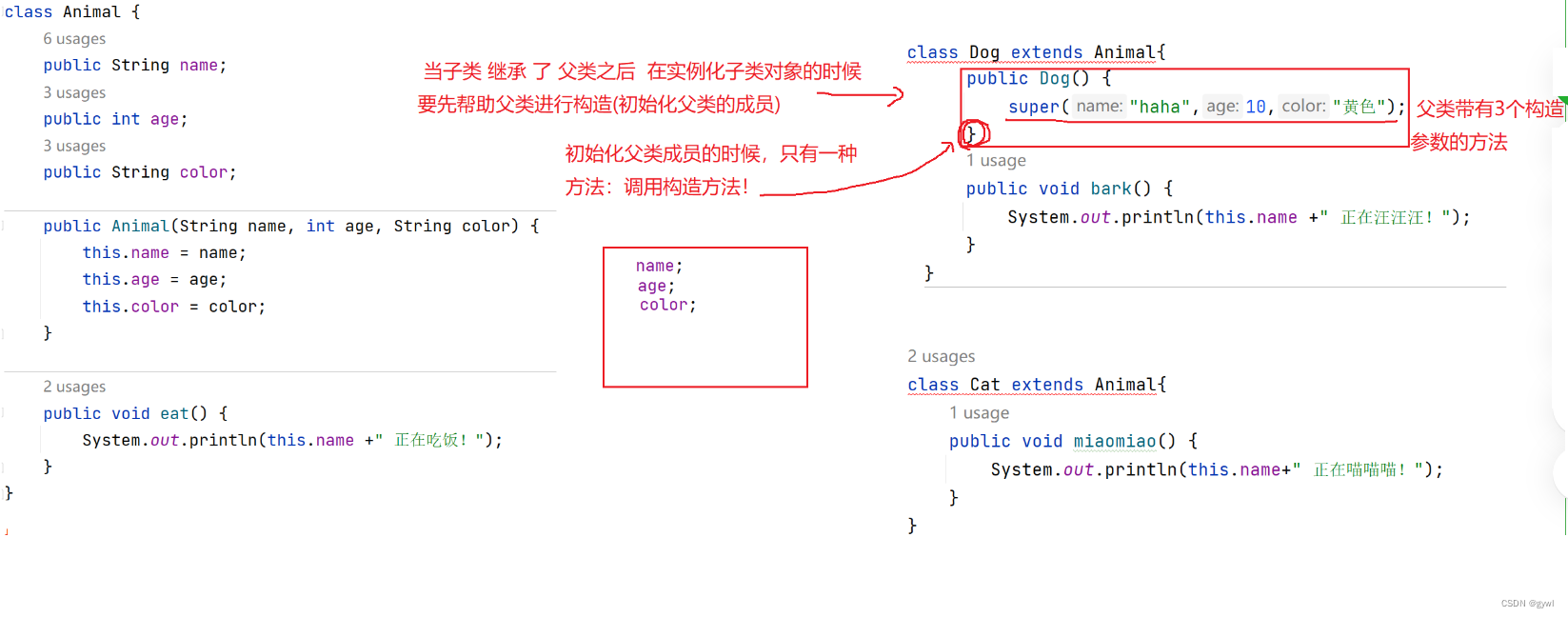
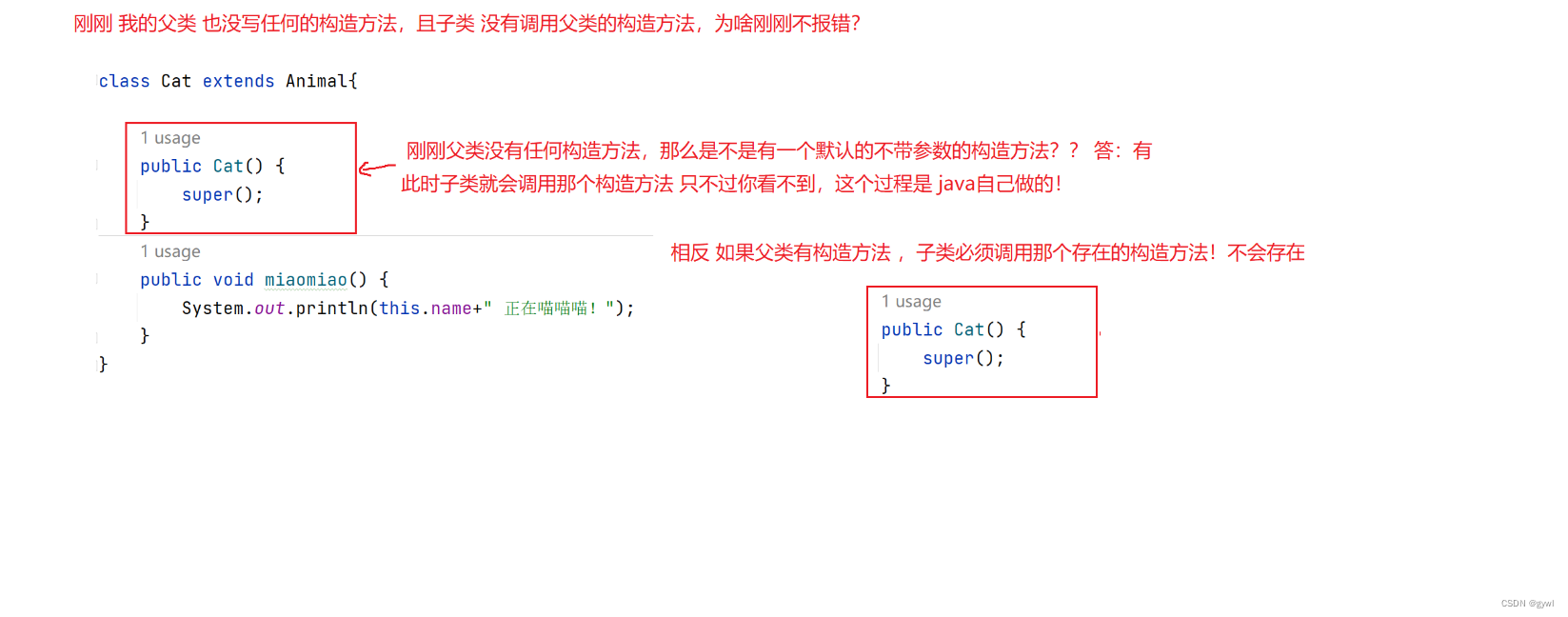
package demo1;
//抽取类的共性
class Animal{public String name;public int age;public String color;public Animal(String name, int age, String color) {this.name = name;this.age = age;this.color = color;System.out.println("Animal(String,int,String)");}public void eat(){System.out.println(this.name+"正在吃饭!");}
}
//is-a的关系
class Dog extends Animal{public Dog(){super("haha",10,"黄色");System.out.println("Dog()");}public void bark(){System.out.println(this.name+"正在汪汪汪!");}
}
class Cat extends Animal{public Cat(String name, int age, String color) {//可通过快捷键super(name, age, color);System.out.println("Cat(String,int,String)");}public void miaomaio(){System.out.println(this.name+"正在喵喵喵!");}
}
public class Test2 {public static void main(String[] args) {Dog dog=new Dog();dog.eat();dog.bark();System.out.println();Cat cat=new Cat("小花",2,"白色");cat.eat();cat.miaomaio();}
}
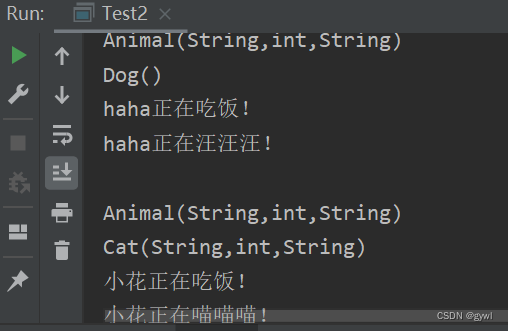
super和this
super和this都可以在成员方法中用来访问:成员变量和调用其他的成员函数,都可以作为构造方法的第一条语句,那他们之间有什么区别呢
【相同点】
1. 都是Java中的关键字
2. 只能在类的非静态方法中使用,用来访问非静态成员方法和字段
3. 在构造方法中调用时,必须是构造方法中的第一条语句,并且不能同时存在
【不同点】
1. this是当前对象的引用,当前对象即调用实例方法的对象,super相当于是子类对象中从父类继承下来部分成员的引用

2. 在非静态成员方法中,this用来访问本类的方法和属性,super用来访问父类继承下来的方法和属性
3. 在构造方法中:this(...)用于调用本类构造方法,super(...)用于调用父类构造方法,两种调用不能同时在构造方法中出现
4. 构造方法中一定会存在super(...)的调用,用户没有写编译器也会增加,但是this(...)用户不写则没有
再谈初始化
我们还记得之前讲过的代码块吗?我们简单回顾一下几个重要的代码块:实例代码块和静态代码块。在没有继承关系时的执行顺序。
class Person {
public String name;
public int age;public Person(String name, int age) {
this.name = name;
this.age = age;
System.out.println("构造方法执行");
} {
System.out.println("实例代码块执行");
} static {
System.out.println("静态代码块执行");
}}public class TestDemo {
public static void main(String[] args) {
Person person1 = new Person("bit",10);
System.out.println("============================");
Person person2 = new Person("gaobo",20);
}}执行结果:
静态代码块执行
实例代码块执行
构造方法执行
============================
实例代码块执行
构造方法执行
1. 静态代码块先执行,并且只执行一次,在类加载阶段执行
2. 当有对象创建时,才会执行实例代码块,实例代码块执行完成后,最后构造方法执行
【继承关系上的执行顺序】
class Person {
public String name;
public int age;public Person(String name, int age) {
this.name = name;
this.age = age;
System.out.println("Person:构造方法执行");
}{
System.out.println("Person:实例代码块执行");
}static {
System.out.println("Person:静态代码块执行");
}}class Student extends Person{
public Student(String name,int age) {
super(name,age);
System.out.println("Student:构造方法执行");
}{
System.out.println("Student:实例代码块执行");
} static {
System.out.println("Student:静态代码块执行");
}}
public class TestDemo4 {
public static void main(String[] args) {
Student student1 = new Student("张三",19);
System.out.println("===========================");
Student student2 = new Student("gaobo",20);
}public static void main1(String[] args) {
Person person1 = new Person("bit",10);
System.out.println("============================");
Person person2 = new Person("gaobo",20);
}
}执行结果:
erson:静态代码块执行
Student:静态代码块执行
Person:实例代码块执行
Person:构造方法执行
Student:实例代码块执行
Student:构造方法执行
===========================
Person:实例代码块执行
Person:构造方法执行
Student:实例代码块执行
Student:构造方法执行
通过分析执行结果,得出以下结论:
1、父类静态代码块优先于子类静态代码块执行,且是最早执行
2、父类实例代码块和父类构造方法紧接着执行
3、子类的实例代码块和子类构造方法紧接着再执行
4、第二次实例化子类对象时,父类和子类的静态代码块都将不会再执行
小练习
package demo1;
//抽取类的共性
class Animal{public String name;public int age;public String color;static{System.out.println("Animal::static{}");}{System.out.println("Animal::{}");}public Animal(String name, int age, String color) {this.name = name;this.age = age;this.color = color;System.out.println("Animal(String,int,String)");}public void eat(){System.out.println(this.name+"正在吃饭!");}
}
//is-a的关系
class Dog extends Animal{static{System.out.println("Dog::static{}");}{System.out.println("Dog::{}");}public Dog(){super("haha",10,"黄色");//虽然调用了父类的构造方法//但是并没有产生父类对象,此时只是帮你进行初始化父类的成员System.out.println("Dog()");}public void bark(){System.out.println(this.name+"正在汪汪汪!");}
}
class Cat extends Animal{static{System.out.println("Cat::static{}");}{System.out.println("Cat::{}");}public Cat(String name, int age, String color) {//可通过快捷键super(name, age, color);System.out.println("Cat(String,int,String)");}public void miaomaio(){System.out.println(this.name+"正在喵喵喵!");}
}
public class Test2 {public static void main(String[] args) {Dog dog1=new Dog();Dog dog2=new Dog();
// dog.eat();
// dog.bark();
// System.out.println();
// Cat cat=new Cat("小花",2,"白色");
// cat.eat();
// cat.miaomaio();}
}

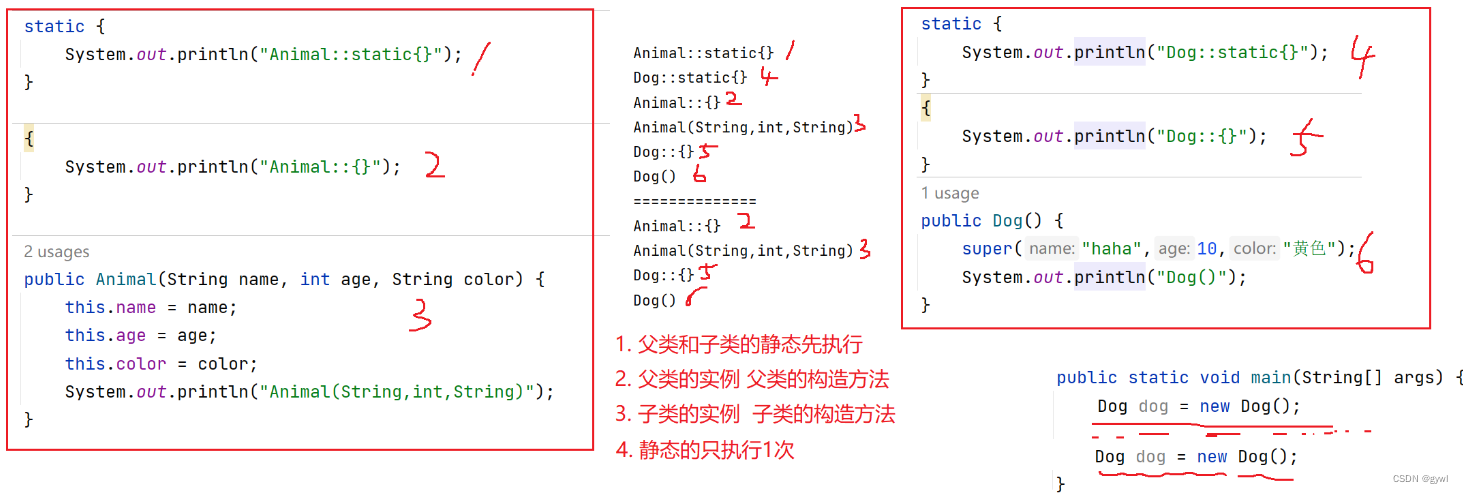
答案:142356 2356
protected关键字
在类和对象章节中,为了实现封装特性,Java中引入了访问限定符,主要限定:类或者类中成员能否在类外或者其他包中被访问。


继承方式
在现实生活中,事物之间的关系是非常复杂,灵活多样,比如:
但在Java中只支持以下几种继承方式:
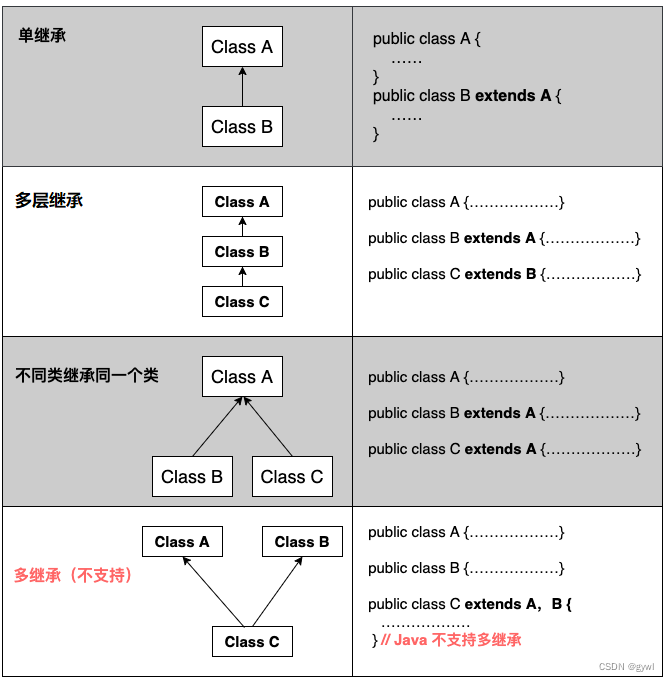
注意:Java中不支持多继承。
时刻牢记, 我们写的类是现实事物的抽象. 而我们真正在公司中所遇到的项目往往业务比较复杂, 可能会涉及到 一系列复杂的概念, 都需要我们使用代码来表示, 所以我们真实项目中所写的类也会有很多. 类之间的关系也会 更加复杂.
但是即使如此, 我们并不希望类之间的继承层次太复杂. 一般我们不希望出现超过三层的继承关系. 如果继承层 次太多, 就需要考虑对代码进行重构了.
如果想从语法上进行限制继承, 就可以使用 final 关键字
final关键字
如果需要控制继承,此时这个类可以被final修饰,意味着:当前类不可以继承,此时这个类叫做密封类。
final关键可以用来修饰变量、成员方法以及类。
1. 修饰变量或字段,表示常量(即不能修改)
final int a = 10;
a = 20;
// 编译出错
2. 修饰类:表示此类不能被继承
final public class Animal {
...
}
public class Bird extends Animal {
...
}
// 编译出错
Error:(3, 27) java: 无法从最终com.bit.Animal进行继承

我们平时是用的 String 字符串类, 就是用 final 修饰的, 不能被继承.
3. 修饰方法:表示该方法不能被重写(后序介绍)
继承与组合
和继承类似, 组合也是一种表达类之间关系的方式, 也是能够达到代码重用的效果。组合并没有涉及到特殊的语法 (诸如 extends 这样的关键字), 仅仅是将一个类的实例作为另外一个类的字段。
继承表示对象之间是is-a的关系,比如:狗是动物,猫是动物
组合表示对象之间是has-a的关系,比如:汽车
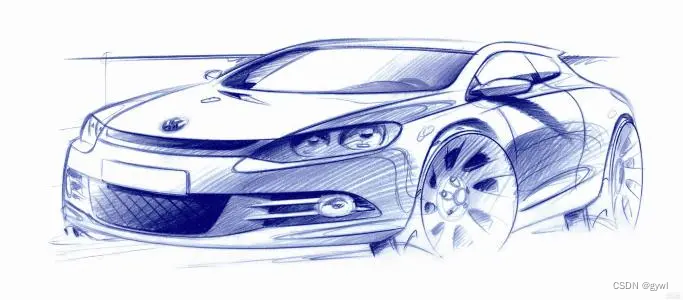

汽车和其轮胎、发动机、方向盘、车载系统等的关系就应该是组合,因为汽车是有这些部件组成的。
// 轮胎类
class Tire{// ...
}// 发动机类
class Engine{// ...
}// 车载系统类
class VehicleSystem{// ...
}class Car{private Tire tire; // 可以复用轮胎中的属性和方法private Engine engine; // 可以复用发动机中的属性和方法private VehicleSystem vs; // 可以复用车载系统中的属性和方法// ...
}// 奔驰是汽车
class Benz extend Car{// 将汽车中包含的:轮胎、发送机、车载系统全部继承下来
}组合和继承都可以实现代码复用,应该使用继承还是组合,需要根据应用场景来选择,一般建议:能用组合尽量用组合。
继承和组合
多态
多态的概念
多态的概念:通俗来说,就是多种形态,具体点就是去完成某个行为,当不同的对象去完成时会产生出不同的状态。
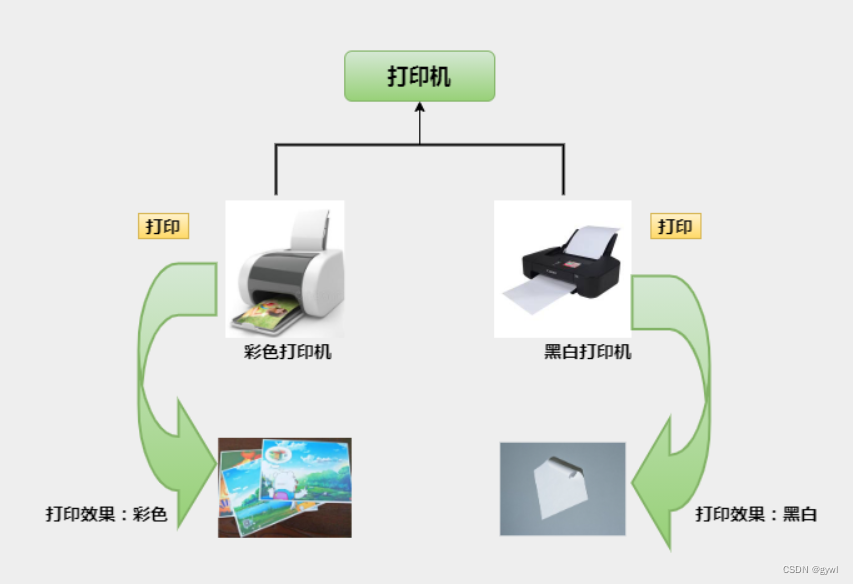
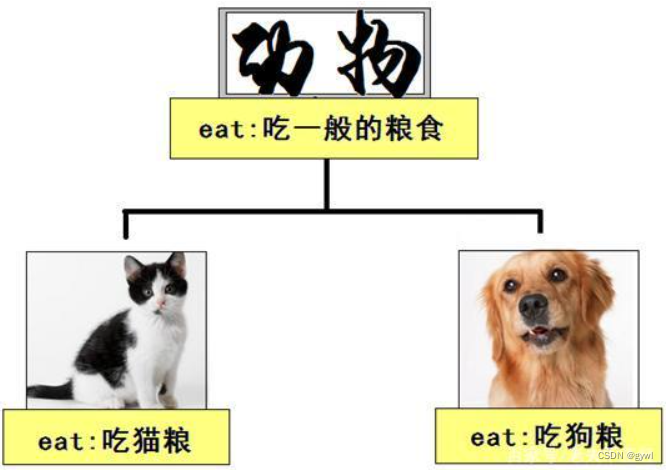
总的来说:同一件事情,发生在不同对象身上,就会产生不同的结果。
多态实现条件
在java中要实现多态, 必须要满足如下几个条件, 缺一不可:
1. 必须在继承体系下
2. 子类必须要对父类中方法进行重写
3. 通过父类的引用调用重写的方法
多态体现:在代码运行时, 当传递不同类对象时, 会调用对应类中的方法 。
public class Animal {
String name;
int age;
public Animal(String name, int age){
this.name = name;
this.age = age;
}
public void eat(){
System.out.println(name + "吃饭");
}
}
public class Cat extends Animal{
public Cat(String name, int age){
super(name, age);
}@
Override
public void eat(){
System.out.println(name+"吃鱼~~~");
}
}
public class Dog extends Animal {
public Dog(String name, int age){
super(name, age);
}@Override
public void eat(){
System.out.println(name+"吃骨头~~~");
}
}///分割线//
public class TestAnimal {
// 编译器在编译代码时,并不知道要调用Dog 还是 Cat 中eat的方法
// 等程序运行起来后,形参a引用的具体对象确定后,才知道调用那个方法
// 注意:此处的形参类型必须时父类类型才可以
public static void eat(Animal a){
a.eat();
}
public static void main(String[] args) {
Cat cat = new Cat("元宝",2);
Dog dog = new Dog("小七", 1);
eat(cat);
eat(dog);
}
}运行结果:
元宝吃鱼~~~
元宝正在睡觉
小七吃骨头~~~
小七正在睡觉
在上述代码中, 分割线上方的代码是类的实现者编写的, 分割线下方的代码是类的调用者编写的.
当类的调用者在编写 eat 这个方法的时候, 参数类型为 Animal (父类), 此时在该方法内部并不知道, 也不关注当前的a 引用指向的是哪个类型(哪个子类)的实例. 此时 a这个引用调用 eat方法可能会有多种不同的表现(和 a 引用的实例相关), 这种行为就称为 多态.
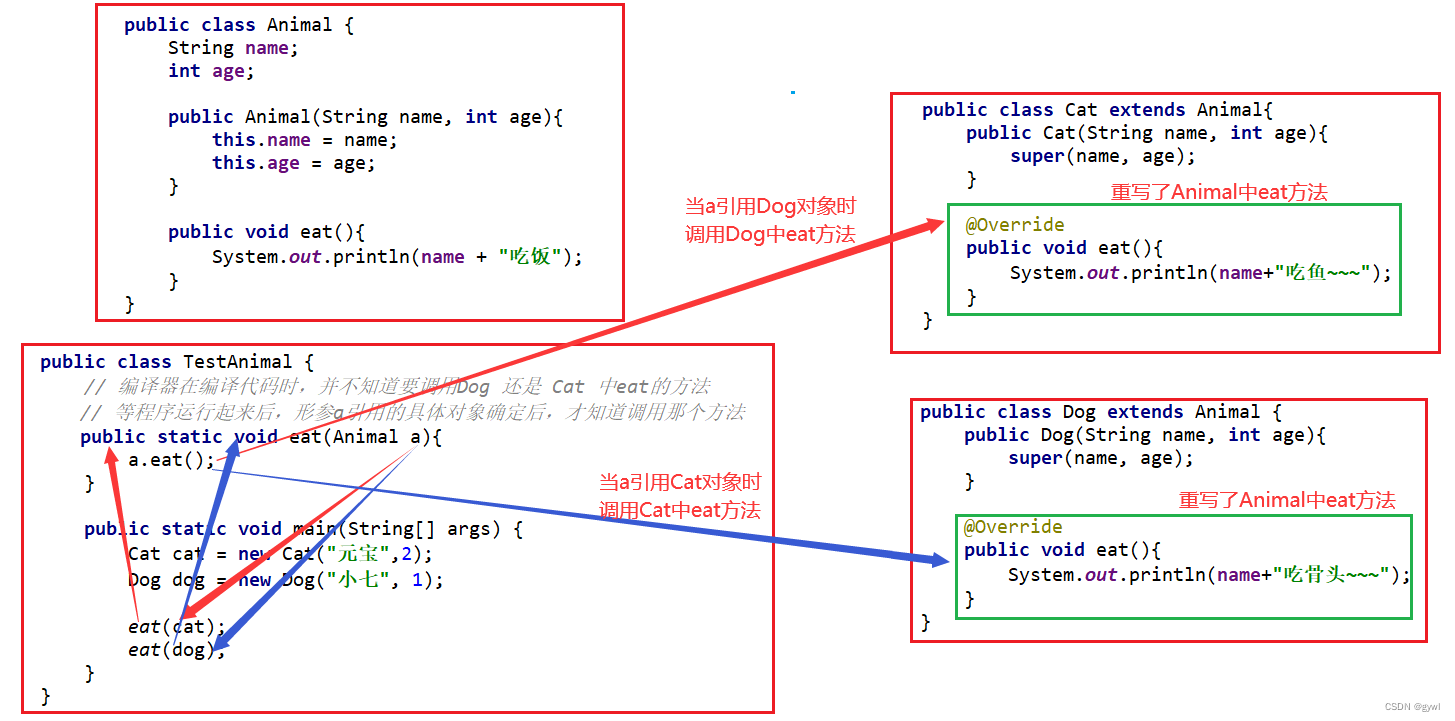
向上转型和向下转型
向上转型
向上转型:实际就是创建一个子类对象,将其当成父类对象来使用。
语法格式:父类类型 对象名 = new 子类类型()
Animal animal = new Cat("元宝",2);
class Animal{public String name;public int age;public void eat(){System.out.println(this.name+"正在吃饭!");}
}class Dog extends Animal{public void bark(){System.out.println(this.name+"汪汪叫");}public void eat(){System.out.println(this.name+"正在吃狗粮!");}
}class Bird extends Animal{public void qiqi(){System.out.println(this.name+"吱吱叫");}}
public class Test {public static void main(String[] args) {/*向上转型:把子类对象给到了父类Dog dog=new Dog();Animal animal=dog;*///可以简写成:Animal animal1=new Dog();animal1.eat();}
}
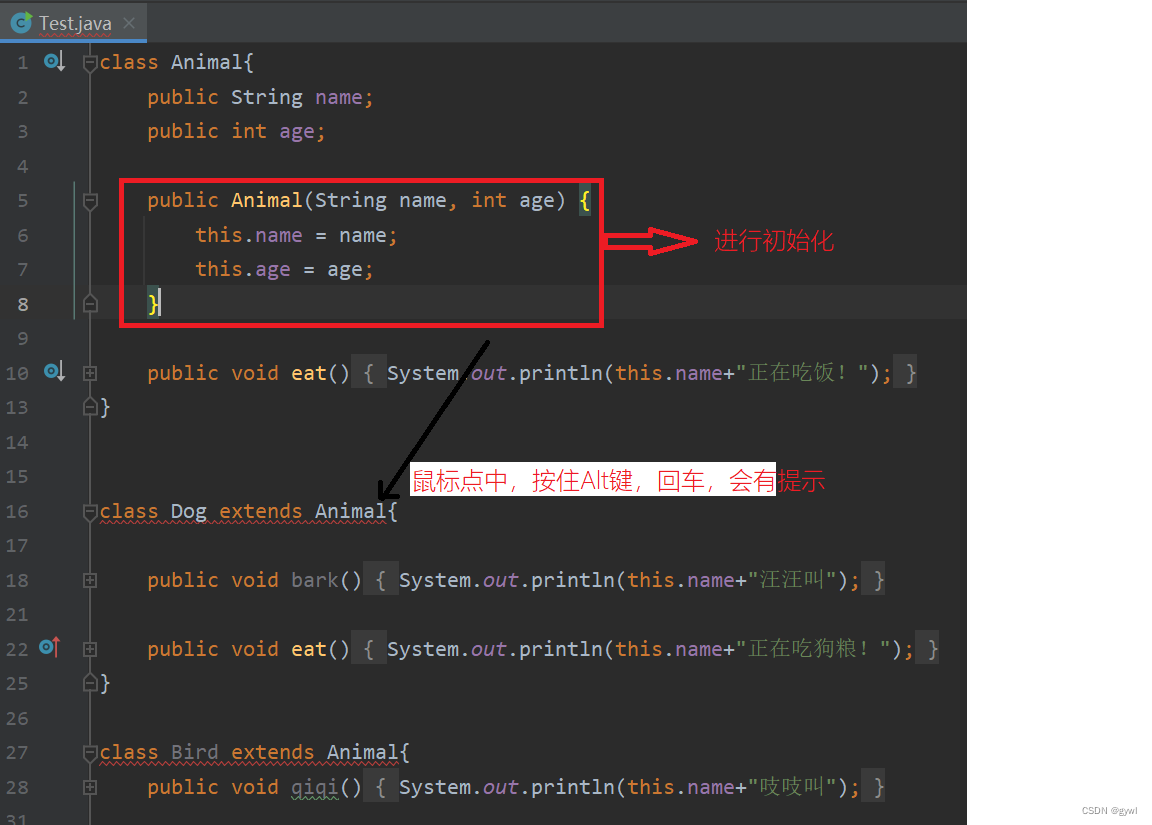

//完整代码:
class Animal{public String name;public int age;public Animal(String name, int age) {this.name = name;this.age = age;}public void eat(){System.out.println(this.name+"正在吃饭!");}
}class Dog extends Animal{public Dog(String name, int age) {super(name, age);}public void bark(){System.out.println(this.name+"汪汪叫");}public void eat(){System.out.println(this.name+"正在吃狗粮!");}
}class Bird extends Animal{public Bird(String name, int age) {super(name, age);}public void qiqi(){System.out.println(this.name+"吱吱叫");}}
public class Test {public static void main(String[] args) {/*向上转型:把子类对象给到了父类Dog dog=new Dog();Animal animal=dog;*///可以简写成:Animal animal1=new Dog("小黄",10);animal1.eat();}
}
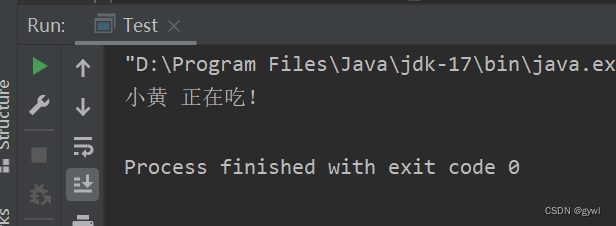
但是如果访问bark就不行了:


class Animal{public String name;public int age;public Animal(String name, int age) {this.name = name;this.age = age;}public void eat(){System.out.println(this.name+" 正在吃!");}
}class Dog extends Animal{public Dog(String name, int age) {super(name, age);}public void bark(){System.out.println(this.name+"汪汪叫");}public void eat(){System.out.println(this.name+" 正在吃狗粮!");}}class Bird extends Animal{public Bird(String name, int age) {super(name, age);}public void qiqi(){System.out.println(this.name+"吱吱叫");}}
public class Test {public static void main(String[] args) {/*向上转型:把子类对象给到了父类Dog dog=new Dog();Animal animal=dog;*///可以简写成:Animal animal1=new Dog("小黄",10);animal1.eat();//animal1.bark();}
}
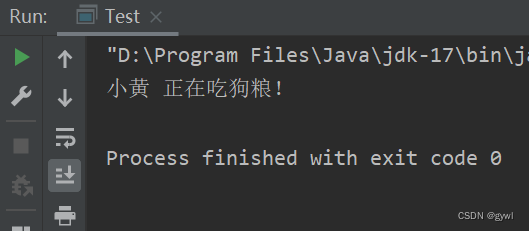

重写也有快捷键:
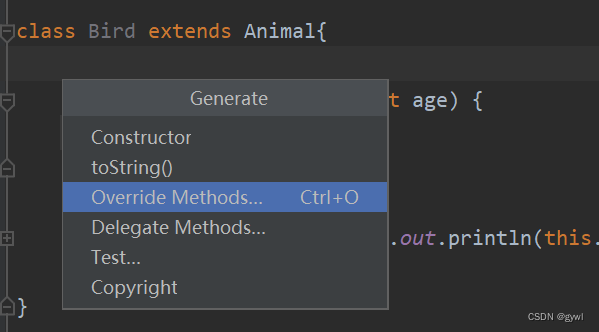

【使用场景】
1. 直接赋值
2. 方法传参
3. 方法返回

向上转型的优点:让代码实现更简单灵活。
向上转型的缺陷:不能调用到子类特有的方法。
向下转型
将一个子类对象经过向上转型之后当成父类方法使用,再无法调用子类的方法,但有时候可能需要调用子类特有的方法,此时:将父类引用再还原为子类对象即可,即向下转换。

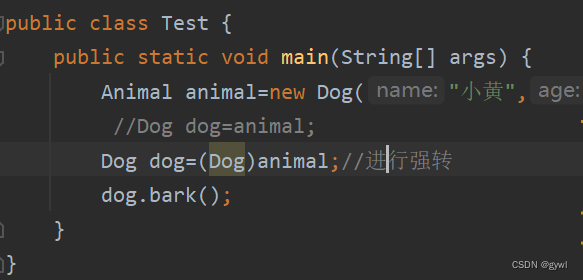
但是不安全:
class Animal{public String name;public int age;public Animal(String name, int age) {this.name = name;this.age = age;}public void eat(){System.out.println(this.name+" 正在吃!");}
}class Dog extends Animal{public Dog(String name, int age) {super(name, age);}public void bark(){System.out.println(this.name+"汪汪叫");}public void eat(){System.out.println(this.name+" 正在吃狗粮!");}}class Bird extends Animal{@Overridepublic void eat() {System.out.println(this.name+" 正在吃鸟粮!");}public Bird(String name, int age) {super(name, age);}public void qiqi(){System.out.println(this.name+"吱吱叫");}}
public class Test {public static void main(String[] args) {Animal animal1=new Dog("小黄",10);Bird bird2=(Bird)animal1;}
}


向下转型用的比较少,而且不安全,万一转换失败,运行时就会抛异常。Java中为了提高向下转型的安全性,引入了 instanceof ,如果该表达式为true,则可以安全转换。
class Animal{public String name;public int age;public Animal(String name, int age) {this.name = name;this.age = age;}public void eat(){System.out.println(this.name+" 正在吃!");}
}class Dog extends Animal{public Dog(String name, int age) {super(name, age);}public void bark(){System.out.println(this.name+"汪汪叫");}public void eat(){System.out.println(this.name+" 正在吃狗粮!");}}class Bird extends Animal{@Overridepublic void eat() {System.out.println(this.name+" 正在吃鸟粮!");}public Bird(String name, int age) {super(name, age);}public void qiqi(){System.out.println(this.name+"吱吱叫");}public void fly(){System.out.println(this.name+" 正在飞!");}}
public class Test {public static void main(String[] args) {Animal animal1=new Dog("小黄",10);if(animal1 instanceof Bird){Bird bird2=(Bird)animal1;bird2.fly();}else{System.out.println("animal1 instanceof Bird not!");}Animal animal2=new Bird("小黄",10);Bird bird=(Bird)animal2;bird.fly();}
}
重写
重写(override):也称为覆盖。重写是子类对父类非静态、非private修饰,非final修饰,非构造方法等的实现过程进行重新编写, 返回值和形参都不能改变。即外壳不变,核心重写!重写的好处在于子类可以根据需要,定义特定于自己的行为。 也就是说子类能够根据需要实现父类的方法。
【方法重写的规则】
1.子类在重写父类的方法时,一般必须与父类方法原型一致: 返回值类型 方法名 (参数列表) 要完2.全一致被重写的方法返回值类型可以不同,但是必须是具有父子关系的
3.访问权限不能比父类中被重写的方法的访问权限更低。例如:如果父类方法被public修饰,则子类中重写该方法就不能声明为 protected
4.父类被static、private修饰的方法、构造方法都不能被重写。
5.重写的方法, 可以使用 @Override 注解来显式指定. 有了这个注解能帮我们进行一些合法性校验. 例如不小心将方法名字拼写错了 (比如写成 aet), 那么此时编译器就会发现父类中没有 aet 方法, 就会编译报错, 提示无法构成重写.
【重写和重载的区别】

【重写的设计原则】
对于已经投入使用的类,尽量不要进行修改。最好的方式是:重新定义一个新的类,来重复利用其中共性的内容,并且添加或者改动新的内容。
例如:若干年前的手机,只能打电话,发短信,来电显示只能显示号码,而今天的手机在来电显示的时候,不仅仅可以显示号码,还可以显示头像,地区等。在这个过程当中,我们不应该在原来老的类上进行修改,因为原来的类,可能还在有用户使用,正确做法是:新建一个新手机的类,对来电显示这个方法重写就好了,这样就达到了我们当今的需求了。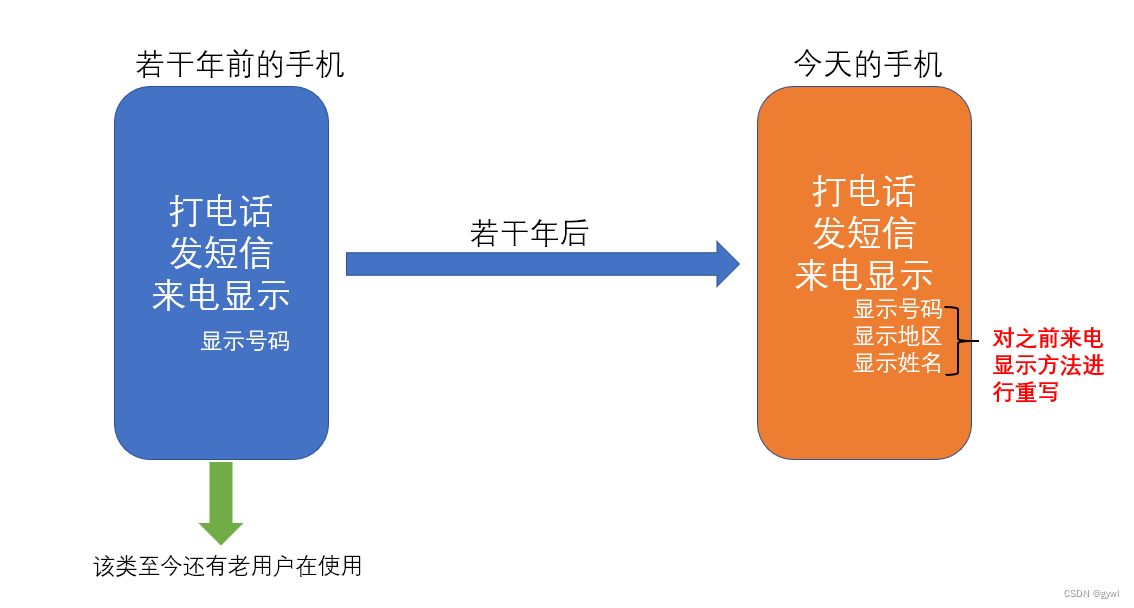
静态绑定:也称为前期绑定(早绑定),即在编译时,根据用户所传递实参类型就确定了具体调用那个方法。典型代表函数重载。
动态绑定:也称为后期绑定(晚绑定),即在编译时,不能确定方法的行为,需要等到程序运行时,才能够确定具体调用那个类的方法。

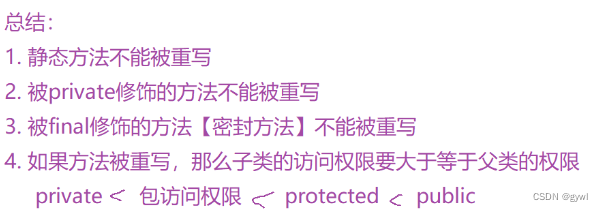
再看多态
class Animal{public String name;public int age;public Animal(String name, int age) {this.name = name;this.age = age;}public void eat(){System.out.println(this.name+" 正在吃!");}
}class Dog extends Animal{public Dog(String name, int age) {super(name, age);}public void bark(){System.out.println(this.name+"汪汪叫");}public void eat(){System.out.println(this.name+" 正在吃狗粮!");}}class Bird extends Animal{@Overridepublic void eat() {System.out.println(this.name+" 正在吃鸟粮!");}public Bird(String name, int age) {super(name, age);}public void qiqi(){System.out.println(this.name+"吱吱叫");}}
public class Test {public static Animal func2(){return new Dog("小黄",10);}public static void func(Animal animal){animal.eat();}public static void main(String[] args) {Dog dog=new Dog("小黄",10);Bird bird=new Bird("小鸟",10);func(dog);func(bird);}
}


多态的优缺点
假设有如下代码
class Shape{public void draw(){System.out.println("画图形!");}
}
class Rect extends Shape{@Overridepublic void draw() {System.out.println("画一个矩形!");}
}
class Cycle extends Shape{@Overridepublic void draw() {System.out.println("画一个圆圈!");}
}
class Triangle extends Shape{@Overridepublic void draw() {System.out.println("画一个三角形!");}
}
public class Test2 {public static void drawMap(Shape shape){shape.draw();}public static void main(String[] args) {drawMap(new Cycle());drawMap(new Rect());drawMap(new Triangle());}
}【使用多态的好处】
1. 能够降低代码的 "圈复杂度", 避免使用大量的 if - else
什么叫 "圈复杂度" ?
圈复杂度是一种描述一段代码复杂程度的方式. 一段代码如果平铺直叙, 那么就比较简单容易理解. 而如果有很多的条件分支或者循环语句, 就认为理解起来更复杂.
因此我们可以简单粗暴的计算一段代码中条件语句和循环语句出现的个数, 这个个数就称为 "圈复杂度".
如果一个方法的圈复杂度太高, 就需要考虑重构.
不同公司对于代码的圈复杂度的规范不一样. 一般不会超过 10
例如我们现在需要打印的不是一个形状了, 而是多个形状. 如果不基于多态, 实现代码如下
public static void drawMaps(){Rect rect=new Rect();Cycle cycle=new Cycle();Triangle triangle=new Triangle();String[] shapes={"1","2","2","1","3"};for(String s:shapes){if(s.equals("1")){cycle.draw();}else if(s.equals("2")){rect.draw();}else if(s.equals("3")){triangle.draw();}}}如果使用使用多态, 则不必写这么多的 if - else 分支语句, 代码更简单.
public static void drawMaps() {Rect rect=new Rect();Shape shapeCycle=new Cycle();Triangle triangle=new Triangle();Shape[] shapes={shapeCycle,rect,rect,shapeCycle,triangle};for (Shape shape:shapes){shape.draw();}}2. 可扩展能力更强
如果要新增一种新的形状, 使用多态的方式代码改动成本也比较低.
class Flower extends Shape{@Overridepublic void draw() {System.out.println("画一朵花!");}
}对于类的调用者来说(drawShapes方法), 只要创建一个新类的实例就可以了, 改动成本很低.
而对于不用多态的情况, 就要把 drawShapes 中的 if - else 进行一定的修改, 改动成本更高.
多态缺陷:代码的运行效率降低。
1. 属性没有多态性
当父类和子类都有同名属性的时候,通过父类引用,只能引用父类自己的成员属性
2. 构造方法没有多态性
避免在构造方法中调用重写的方法(了解)
一段有坑的代码. 我们创建两个类, B 是父类, D 是子类. D 中重写 func 方法. 并且在 B 的构造方法中调用 func
class B {public B() {
// do nothingfunc();}public void func() {System.out.println("B.func()");}
}
class D extends B {private int num = 1;@Overridepublic void func() {System.out.println("D.func() " + num);}
}
public class Test3 {public static void main(String[] args) {D d = new D();}
}执行结果:
D.func() 0
构造 D 对象的同时, 会调用 B 的构造方法.
B 的构造方法中调用了 func 方法, 此时会触发动态绑定, 会调用到 D 中的 func
此时 D 对象自身还没有构造, 此时 num 处在未初始化的状态, 值为 0. 如果具备多态性,num的值应该是1.
所以在构造函数内,尽量避免使用实例方法,除了final和private方法
结论: "用尽量简单的方式使对象进入可工作状态", 尽量不要在构造器中调用方法(如果这个方法被子类重写, 就会触发动态绑定, 但是此时子类对象还没构造完成), 可能会出现一些隐藏的但是又极难发现的问题.
